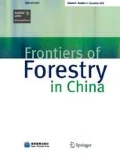Abstract
Ecological footprint (EF) is one of the most important indicators in assessing the status and capacity of sustainable development. In this paper, the EF of Yanbian forest region, Jilin Province, Northeast China, was calculated and analyzed by statistical yearbooks and forest yearbooks from 1996 to 2002. Results showed that the EF per capita decreased, ecological carrying capacity (ECC) per capita almost kept a static status, and ecological surplus per capita increased year after year. The EF per 10 thousand Yuan GDP per capita in Yanbian decreased from 1996 to 2002. This trend was similar to that in western China, and distinctly higher than that in eastern China. The forest EF per capita kept a steady status, while the forest production footprint (FPF) and forest export footprint (FEF) decreased. Comparing the two years before and after the implementation of Natural Forest Protection Program (NFPP) with the five years, the mean va1ue of FPF and FEF reduced by 0.341 (46.32%) and 0.327 hm2 per capita (54.94%), respectively. In conclusion, the regional and forest development in Yanbian was sustainable, and the implementation of NFPP was favorable to improving sustainable development of forest region. However, the sustainability capacity was still lower than those in forest developed countries. Therefore, it is very necessary to improve forest productivity, resource use efficiency and management of forest ecosystems scientifically.
Similar content being viewed by others
References
Bai G X (2004). Study on Regional Forestry Sustainability in Yanbian. Yanji: Yanbian People’s Publishing House (in Chinese)
Erb K H (2004). Actual land demand of Austria 1926–2000: A variation on ecological footprint assessments. Land Use Policy, 21: 247–259
Ferng J J (2001). Using composition of land multiplier to estimate ecological footprints associated with production activity. Ecol Econ, 37(2): 159–172
Haberl H, Erb K, Krausmann F (2001). How to calculate and interpret ecological footprints for long periods of time: The case of Austria 1926–1995. Ecol Econ, 38(1): 25–45
Hanley N, Moffatt I, Faichney R, Wilson M (1999). Measuring sustainability: A time series of alternative indicators for Scotland. Ecol Econ, 28: 55–73
Hunter C (2002). Sustainable tourism and the touristic ecological footprint. Environ Dev Sustain, 4(1): 7–20
Jiang Z H (2000). Modern Forestry of China. Beijing: China Forestry Publishing House, 5–65 (in Chinese)
Li W H (2004). Degradation and restoration of forest ecosystems in China. Forest Ecol Manag, 201: 33–41
Liu L, Zheng J S (2003). Study on regional sustainability of ecological consumption in northeast China. Sci Geogr Sin, 23(6): 656–670 (in Chinese)
Liu Y H, Peng X Z (2004). Time series of ecological footprint in China between 1962–2001: Calculation and assessment of development sustainability. Acta Ecol Sin, 24(10): 2,257–2,262 (in Chinese)
Monfreda C, Wackernagel M, Deumling D (2004). Establishing national natural capital accounts based on detailed ecological footprint and biological capacity assessments. Land Use Policy, 21: 231–246
Wackernagel M, Monfreda C, Erb K H (2004). Ecological footprint time series of Austria, the Philippines, and South Korea for 1961–1999: Comparing the conventional approach to the “actual land area” approach. Ecol Econ, 21: 261–269
Wackernagel M, Onisto L, Bello P, Linares A C, Falfán I S L, García J M, Guerrero S I S, Guerrero M G S (1999). National natural capital accounting with the ecological footprint concept. Ecol Econ, 29: 375–390
Wackernagel M, Rees W (1996). Our Ecological Footprint: Reducing Human Impact on the Earth. Philadelphia: New Society Publishers
Wang S, van Kooten G C, Wilson B M (2004). Mosaic of reform: Forest policy in post-1978 China. For Policy Econ, 6(1): 71–83
Xu Z M, Zhang Z Q (2000). Review indicators measuring sustainable development. Chin Popul Resour Environ, 10(2): 60–64 (in Chinese)
Xu Z M, Zhang Z Q, Cheng G D, Chen D J (2003). Ecological footprint calculation and development capacity analysis of China in 1999. Chin J Appl Ecol, 14(2): 280–285 (in Chinese)
Yanbian Region Forestry Management Administration (1998–2003). Yanbian Forestry Yearbook (1997–2001). Yanji: Yanbian Region Forestry Management Administration (in Chinese)
Yanbian Statistic Bureau (1997–1998). Yanbian Statistic Yearbook (1996–1997). Beijing: China Statistics Press (in Chinese)
Yanbian Statistic Bureau (2000–2002). Yanbian Statistic Yearbook (1999–2001). Yanji: Yanbian People Publishing House (in Chinese)
Yanbian Statistic Bureau (2003). Yanbian Statistic Yearbook (2002). Changchun: Jilin People Publishing House (In Chinese)
Zhang P C, Shao G F, Zhao G, Master D C L, Parker G R, Dunning J B, Li Q L (2000). China’s forest policy for the 21st century. Science, 288: 2,135–2,136
Zhang Z Q, Xu Z M, Chen G D, Chen D J (2001). The ecological footprints of the l2 provinces of west China in l999. Acta Geogr Sin, 56(5): 599–610 (in Chinese)
Zhu C Q, Rodney T, Feng G Q (2004). China’s Wood Market, Trade and the Environment. Beijing: Science Press, 1–61
Author information
Authors and Affiliations
Corresponding author
Additional information
__________
Translated from Chinese Journal of Ecology, 2006, 25(2): 129–134 [译自: 生态学杂志]
About this article
Cite this article
Hu, X., Chen, F., Hu, A. et al. Sustainability assessment for Yanbian forest region, Jilin Province, Northeast China, based on ecological footprint model. Front. Forest. China 2, 390–395 (2007). https://doi.org/10.1007/s11461-007-0062-8
Issue Date:
DOI: https://doi.org/10.1007/s11461-007-0062-8




